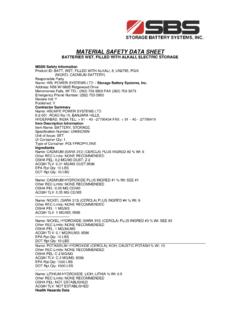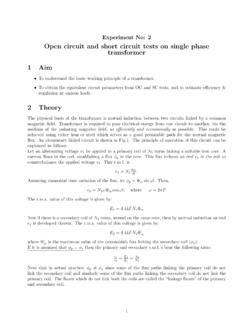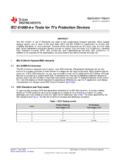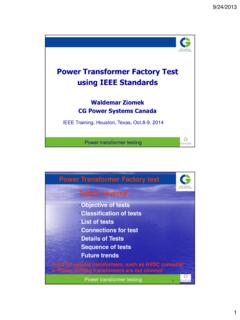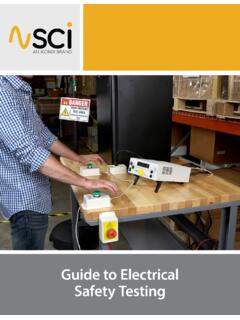Transcription of CALCULATED VS. ACTUAL SHORT CIRCUIT CURRENTS FOR …
1 7 1 CALCULATED VS. ACTUAL SHORT CIRCUIT CURRENTS FOR VRLA BATTERIES Scott D. Gerner Manager, Product Development Paul D. Korinek Director, Product Engineering C&D Technologies Tom E. Ruhlmann Manager, Technical ServicesMilwaukee, WI 53212 INTRODUCTION A shorted lead acid battery has the capability of delivering an extremely high current, 100 to 1000 times the typical discharge current used in most applications. Electrical systems using batteries must be properly protected to avoid potentially dangerous fault conditions. In this paper, we compare the SHORT CIRCUIT CURRENTS as predicted using generally accepted estimation methods versus ACTUAL measured values for individual batteries and battery systems.
2 Practical considerations such as the effects of temperature, state of charge and type of CIRCUIT protection device are also presented. A battery s SHORT CIRCUIT current is typically estimated by dividing its open CIRCUIT voltage by its internal resistance. While the true DC internal resistance can be determined using a series of discharge tests , it is often simpler to directly measure the battery s impedance or conductance using an AC test signal; several test units are commercially available. Due to differences in resistance versus impedance values, the CALCULATED SHORT CIRCUIT CURRENTS will naturally be different from those obtained using traditional DC test methods. OBJECTIVES In this paper, the following topics regarding SHORT CIRCUIT current are presented: - Comparison of values obtained using estimation methods versus ACTUAL measurements for a range of VRLA battery designs - Comparison of resistance, impedance and conductance measurements as a predictive tool - Effects of temperature, state of charge and CIRCUIT resistance BATTERY DESIGN In DC systems, a shorted battery has the potential to deliver an extremely high current in a SHORT amount of time.
3 The magnitude of the current is dependent upon the battery s internal resistance and the external CIRCUIT resistance. The battery s internal resistance is related to product design attributes such as plate surface area, inter-plate spacing, separator material type, electrolyte type (gel or absorbed liquid), acid gravity and saturation, connecting strap/weld/terminal post diameters and grid design. For new batteries, both state of charge and temperature can have modifying effects on the internal resistance. As a VRLA battery ages, the resistance often rises due to corrosion of the positive grid, changes in active material structure and electrolyte dry out. The total resistance of the battery string is the sum of the battery internal resistances plus the resistance of external components such as inter-connection hardware and CIRCUIT protection devices.
4 The amount of time to achieve maximum current depends upon such factors as the capacitive and inductive reactance of the battery and the external CIRCUIT , as well as the battery s electrochemical response1. Often, the peak SHORT CIRCUIT current occurs within 5 to 15 milliseconds. Without some form of protection such as a fuse or breaker, a SHORT CIRCUIT condition can cause permanent damage to the battery. In effect the battery can itself becomes the fuse. If the weakest link is within the battery, melting and opening of an internal connection has the potential to ignite the hydrogen/oxygen gas mixture contained within the battery headspace, resulting in a potentially dangerous situation.
5 Melting of the external inter-battery connections may occur, particularly if the terminal connections are loose. While an external failure typically results in a more benign open CIRCUIT condition, severe and/or prolonged overheating may lead to permanent battery and equipment damage, including the potential for fire. 7 2 SHORT CIRCUIT CURRENT ESTIMATION Using Ohm s law, the potential maximum, zero voltage SHORT CIRCUIT current can be CALCULATED by dividing the battery s nominal open CIRCUIT voltage by its resistance (I = V/R). By discharge testing over a wide range of CURRENTS and measuring the battery s voltage response, its internal resistance can be CALCULATED from the slope of the voltage versus current (R = dV/dI).
6 Extrapolating this line back to zero volts yields the resistance-free or zero voltage SHORT CIRCUIT current. As the range and magnitude of discharge CURRENTS increase, the accuracy of the resistance and SHORT CIRCUIT current values increase. In IEC896-2 Stationary Lead-Acid Batteries, Part 2: Valve Regulated Types , the estimated SHORT CIRCUIT current is obtained by discharging a battery at 4 times and 20 times its rated 10 hour discharge current (I10 at 25oC to volts per cell). At the 4X rate, the battery voltage is measured at 20 seconds. After a 5 minute rest without recharge, the battery is discharged at the 20X rate and the voltage is measured after 5 seconds. From these two points, a line is extrapolated back to zero volts to calculate the SHORT CIRCUIT current.
7 A rule of thumb estimation method suggests multiplying the 1 minute rate by 10 to obtain the SHORT CIRCUIT current; however, there may be a wide variation between estimated and ACTUAL values depending on battery design. TEST METHOD AND EQUIPMENT Standard production C&D Dynasty Division VRLA batteries were tested. Products spanned the full range of product sizes, from 33 to 200 AH (20 hour AH capacity), including batteries using gelled and absorbent glass mat (AGM) construction. All the battery models are multi-cell, nominal 12 volt design, with the exception of the 6 volt 200 AH product. Typically, three samples of each type were tested. Batteries were boosted to full state of charge and allowed to rest for 72 hours before measuring the open CIRCUIT voltage (OCV), impedance and conductance.
8 The following commercially available test equipment was used to measure impedance or conductance: Manufacturer Model Type Frequency Hewlett Packard HP4328A Impedance 1000 Hz Biddle Bite Impedance 60 Hz Alber Cellcorder Resistance N/A Midtronics Micro Celltron Conductance unknown Each battery was constant current discharged at 25oC at 4X its rated AH capacity for 20 seconds with voltage and current readings taken at second intervals and at 20X for 5 seconds at second intervals, per the IEC standard. The voltage and current was recorded using an Agilent 34970 data-logger. Some batteries were given additional discharges at 100X and 200X for 3 seconds with readings taken at second intervals to obtain additional current and voltage points for a trend-line fit and extrapolation to zero volts.
9 After testing, batteries were recharged. Finally, each battery was dead shorted , connected to a shorting CIRCUIT consisting of a shunt (5000A+ ), Hall effect transducer [model LEM LT 4000T (4000A+ )], 26 feet of MCM-550 cable and a knife switch. A 2 channel Fluke 190 Scopemeter with automatic triggering was attached to the Hall effect transducer and to the battery terminals. Current and voltage readings were recorded at millisecond time intervals from 0 to seconds. An Agilent 34970 data-logger was used to monitor the shunt current and battery terminal voltage at 40 millisecond time intervals from 0 to 30 seconds. The shorting CIRCUIT had a resistance of milli-ohms, as measured with a Biddle DLRO micro-ohmmeter.
10 The inductance of the CIRCUIT was not measured. To determine the effect of temperature, sets of UPS12-140 (12V-33AH) batteries were float charged at ( volts/cell) for 48 hours at 2, 11, 24, 33 and 40oC in a temperature-controlled environment. OCV, impedance and conductance readings were measured and each battery was dead SHORT tested using the test method described above. To measure the effect of state of charge (SOC%), similar dead SHORT tests were conducted on a set of nine UPS12-170 batteries (12V-50AH). Individual batteries were constant current discharged at the 5 hour rate ( ) for 0, , and hours at 25oC to achieve respective SOC values of 100, 78, 57 and 35% based on the 20 hour AH capacity.
